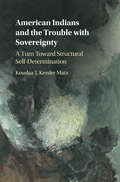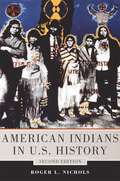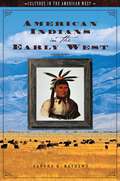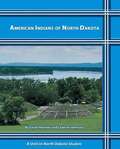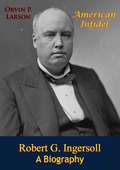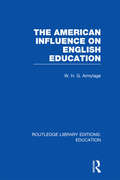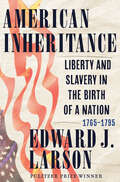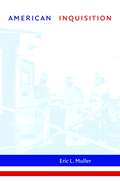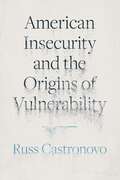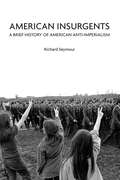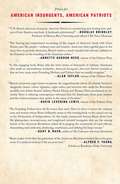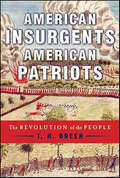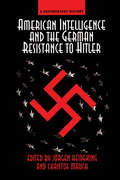- Table View
- List View
American Indians and the Trouble with Sovereignty: A Turn Toward Structural Self-Determination
by Kessler-Mata Kouslaa T.With tribes and individual Indians increasingly participating in American electoral politics, this study examines the ways in which tribes work together with state and local governments to overcome significant governance challenges. Much scholarship on tribal governance continues to rely on a concept of tribal sovereignty that does not allow for or help structure this type of governance activity. The resulting tension which emerges in both theory and practice from American Indian intergovernmental affairs is illuminated here and the limits of existing theory are confronted. Kessler-Mata presents an argument for tribal sovereignty to be normatively understood and pragmatically pursued through efforts aimed at interdependence, not autonomy. By turning toward theories of federalism and freedom in the republican tradition, the author provides an alternative framework for thinking about the goals and aspirations of tribal self-determination.
American Indians in U.S. History (Second Edition)
by Roger L. NicholsThe author traces tribal experiences through four eras: Indian America prior to the European invasions; the colonial period; the emergence of the United States as the dominant power in North America and its subsequent invasion of Indian lands; and the years from 1900 to the present. Nichols uses both Euro-American sources and tribal stories to illuminate the problems Indian people and their leaders have dealt with in every generation.
American Indians in the Early West (Cultures in the American West)
by Sandra K. MathewsMathews (history, U. of New Mexico) offers an alternative view to histories that concentrate on the violent and often tragic confrontations between native Americans and Anglo-Americans in the 19th century. Instead, she concentrates on the clashes between the Indian nations and colonizers that began almost 300 years before the United States was born. Topics include the origins, migrations and geographical location of the earlier native Americans, the history of the Spanish in the southwest, the history of the French from the Saint Lawrence and Great Lakes to the Rocky Mountains and Russian involvement from the Aleutian Chain to Northern California. The book also addresses major issues in the study of American Indian history. Annotation ©2008 Book News, Inc., Portland, OR (booknews.com)
American Indians of North Dakota (North Dakota Studies)
by Gwyn S. Herman Laverne A. JohnsonThis book is filled with interesting history, impressive facts, and inspiring profiles. Through reading and engaging in the variety of activities that accompany this text, you will find yourself on a dynamic and educational journey of discovery.
American Indians of the Pikes Peak Region
by Pikes Peak Historical Society Celinda R. KaelinThousands of years before Zebulon Pike's name became attached to this famous mountain, Pikes Peak was home to indigenous people. These First Nations left no written record of their sojourn here, but what they did leave were stone circles, carefully crafted arrowheads and stone tools, enigmatic petroglyphs, and culturally scarred trees. In the 1500s, Spanish explorers documented their locations, language, and numbers. In the 1800s, mountain men and official explorers such as Pike, Fremont, and Long also wrote about these First Nations. Comanche, Apache, Arapaho, Cheyenne, Kiowa, and Lakota made incursions into the region. These nations contested Ute land possession, harvested the abundant wildlife, and paid homage to the powerful spirits at Garden of the Gods and Manitou Springs. Today Ute Indians return to Garden of the Gods and to Pikes Peak each year to perform their sacred Sundance Ceremony.
American Infidel: Robert G. Ingersoll, A Biography
by Orvin P. LarsonThe definitive biography of the man who more than any other figure in the history of the United States influenced the course of popular thought in the realm of unorthodoxy."...one of the bravest, grandest champions of human liberty the world has ever seen."Rediscover Robert Green Ingersoll. Celebrated orator of 19th century America, lawyer, Civil War officer, personal friend of three US presidents, the individual most responsible for the flowering of freethought in the United States.
American Influence on English Education (Routledge Library Editions: Education)
by W H ArmytageThe American ideal has exercised a powerful influence over English educational policy over the last two centuries, even as it has itself changed. Today the very size of America enables it to rehearse problems we shall meet tomorrow. This volume answers key questions for education, as relevant now as they were when it was originally published: Is there an optimal size and a maximal use of a school? Are there adequately sophisticated batteries of attainment tests? Or valid methods of vocational guidance?
American Inheritance: Liberty and Slavery in the Birth of a Nation, 1765-1795
by Edward J. LarsonFrom a Pulitzer Prize winner, a powerful history that reveals how the twin strands of liberty and slavery were joined in the nation’s founding. New attention from historians and journalists is raising pointed questions about the founding period: was the American revolution waged to preserve slavery, and was the Constitution a pact with slavery or a landmark in the antislavery movement? Leaders of the founding who called for American liberty are scrutinized for enslaving Black people themselves: George Washington consistently refused to recognize the freedom of those who escaped his Mount Vernon plantation. And we have long needed a history of the founding that fully includes Black Americans in the Revolutionary protests, the war, and the debates over slavery and freedom that followed. We now have that history in Edward J. Larson’s insightful synthesis of the founding. With slavery thriving in Britain’s Caribbean empire and practiced in all of the American colonies, the independence movement’s calls for liberty proved narrow, though some Black observers and others made their full implications clear. In the war, both sides employed strategies to draw needed support from free and enslaved Blacks, whose responses varied by local conditions. By the time of the Constitutional Convention, a widening sectional divide shaped the fateful compromises over slavery that would prove disastrous in the coming decades. Larson’s narrative delivers poignant moments that deepen our understanding: we witness New York’s tumultuous welcome of Washington as liberator through the eyes of Daniel Payne, a Black man who had escaped enslavement at Mount Vernon two years before. Indeed, throughout Larson’s brilliant history it is the voices of Black Americans that prove the most convincing of all on the urgency of liberty.
American Inquisition
by Eric L. MullerWhen the U.S. government forced 70,000 American citizens of Japanese ancestry into internment camps in 1942, it created administrative tribunals to pass judgment on who was loyal and who was disloyal. In American Inquisition, Eric Muller relates the untold story of exactly how military and civilian bureaucrats judged these tens of thousands of American citizens during wartime. Some citizens were deemed loyal and were freed, but one in four was declared disloyal to America and condemned to repressive segregation in the camps or barred from war-related jobs. Using cultural and religious affiliations as indicators of Americans' loyalties, the far-reaching bureaucratic decisions often reflected the agendas of the agencies that performed them rather than the actual allegiances or threats posed by the citizens being judged, Muller explains.American Inquisition is the only study of the Japanese American internment to examine the complex inner workings of the most draconian system of loyalty screening that the American government has ever deployed against its own citizens. At a time when our nation again finds itself beset by worries about an "enemy within" considered identifiable by race or religion, this volume offers crucial lessons from a recent and disastrous history.
American Insecurity and the Origins of Vulnerability
by Russ CastronovoAn incisive critique that examines the origins of contemporary American ideas about surveillance, terrorism, and white supremacyFor more than three centuries, Americans have pursued strategies of security that routinely make them feel vulnerable, unsafe, and insecure. American Insecurity and the Origins of Vulnerability probes this paradox by examining American attachments to the terror of the sublime, the fear of uncertainty, and the anxieties produced by unending racial threat.Challenging conventional approaches that leave questions of security to policy experts, Russ Castronovo turns to literature, philosophy, and political theory to show how security provides an organizing principle for collective life in ways that both enhance freedom and limit it. His incisive critique ranges from frontier violence and white racial anxiety to insurgent Black print culture and other forms of early American terror, uncovering the hidden logic of insecurity that structures modern approaches to national defense, counterterrorism, cybersecurity, surveillance, and privacy. Drawing on examples from fiction, journalism, tracts, and pamphlets, Castronovo uncovers the deep affective attachments that Americans have had since the founding to the sources of fear and insecurity that make them feel unsafe.Timely and urgent, American Insecurity and the Origins of Vulnerability sheds critical light on how and why the fundamental political desire for security promotes unease alongside assurance and fixates on risk and danger while clamoring for safety.
American Insurgents
by Richard Seymour"Seymour's obsessively researched, impressive first book holds its place as the most authoritative historical analysis of its kind."--Resurgence All empires spin self-serving myths, and in the United States the most potent of these is that America is a force for democracy around the world. Yet there is a tradition of American anti-imperialism which gives the lie to this mythology. Richard Seymour examines this complex relationship from the Revolution to the present-day. Richard Seymour is a socialist writer and runs the blog Lenin's Tomb. He is the author of The Liberal Defense of Murder. His articles have appeared in the Guardian and New Statesman.
American Insurgents, American Patriots: The Revolution of the People
by T. H. BreenBefore there could be a revolution, there was a rebellion; before patriots, there were insurgents. Challenging and displacing decades of received wisdom, T. H. Breen's strikingly original book explains how ordinary Americans - most of them members of farm families living in small communities - were drawn into a successful insurgency against imperial authority. This is the compelling story of our national political origins that most Americans do not know. It is a story of rumor, charity, vengeance, and restraint. American Insurgents, American Patriotsreminds us that revolutions are violent events. They provoke passion and rage, a willingness to use violence to achieve political ends, a deep sense of betrayal, and a strong religious conviction that God expects an oppressed people to defend their rights. The American Revolution was no exception. A few celebrated figures in the Continental Congress do not make for a revolution. It requires tens of thousands of ordinary men and women willing to sacrifice, kill, and be killed. Breen not only gives the history of these ordinary Americans but, drawing upon a wealth of rarely seen documents, restores their primacy to American independence. Mobilizing two years before the Declaration of Independence, American insurgents in all thirteen colonies concluded that resistance to British oppression required organized violence against the state. They channeled popular rage through elected committees of safety and observation, which before 1776 were the heart of American resistance. American Insurgents, American Patriotsis the stunning account of their insurgency, without which there would have been no independent republic as we know it.
American Insurgents, American Patriots: The Revolution of the People
by T. H. BreenBefore there could be a revolution, there was a rebellion; before patriots, there were insurgents. Challenging and displacing decades of received wisdom, T. H. Breen's strikingly original book explains how ordinary Americans—most of them members of farm families living in small communities—were drawn into a successful insurgency against imperial authority. This is the compelling story of our national political origins that most Americans do not know. It is a story of rumor, charity, vengeance, and restraint. American Insurgents, American Patriots reminds us that revolutions are violent events. They provoke passion and rage, a willingness to use violence to achieve political ends, a deep sense of betrayal, and a strong religious conviction that God expects an oppressed people to defend their rights. The American Revolution was no exception. A few celebrated figures in the Continental Congress do not make for a revolution. It requires tens of thousands of ordinary men and women willing to sacrifice, kill, and be killed. Breen not only gives the history of these ordinary Americans but, drawing upon a wealth of rarely seen documents, restores their primacy to American independence. Mobilizing two years before the Declaration of Independence, American insurgents in all thirteen colonies concluded that resistance to British oppression required organized violence against the state. They channeled popular rage through elected committees of safety and observation, which before 1776 were the heart of American resistance. American Insurgents, American Patriots is the stunning account of their insurgency, without which there would have been no independent republic as we know it.
American Intelligence And The German Resistance: A Documentary History
by Jurgen HeidekingEven paranoids have enemies. Hitler's most powerful foes were the Allied powers, but he also feared internal conspiracies bent on overthrowing his malevolent regime. In fact, there was a small but significant internal resistance to the Nazi regime, and it did receive help from the outside world. Through recently declassified intelligence documents, this book reveals for the first time the complete story of America's wartime knowledge about, encouragement of, and secret collaboration with the German resistance to Hitler?including the famous July 20th plot to assassinate the Fuehrer.The U.S. government's secret contacts with the anti-Nazi resistance were conducted by the OSS, the World War II predecessor to the CIA. Highly sensitive intelligence reports recently released by the CIA make it evident that the U.S. government had vast knowledge of what was going on inside the Third Reich. For example, a capitulation offer to the western Allies under consideration by Count von Moltke in 1943 was thoroughly discussed within the U.S. government. And Allen Dulles, who was later to become head of the CIA, was well informed about the legendary plot of July 20th. In fact, these secret reports from inside Germany provide a well-rounded picture of German society, revealing the pro- or anti-Nazi attitudes of different social groups (workers, churches, the military, etc.). The newly released documents also show that scholars in the OSS, many of them recruited from ivy-league universities, looked for anti-Nazi movements and leaders to help create a democratic Germany after the war.Such intelligence gathering was a major task of the OSS. However, OSS director ?Wild Bill? Donovan and others favored subversive operations, spreading disinformation, and issuing propaganda. Unorthodox and often dangerous schemes were developed, including bogus ?resistance newspapers,? anti-Nazi letters and postcards distributed through the German postal service, sabotage, and fake radio broadcasts from ?German generals? calling for uprisings against the regime.This is much more than a documentary collection. Explanatory footnotes supply a wealth of background information for the reader, and a comprehensive introduction puts the documents into their wider historical perspective. Arranged in chronological order, these intelligence reports provide a fascinating new perspective on the story of the German resistance to Hitler and reveal an intriguing and previously unexplored aspect of America's war with Hitler.
American Intelligence in War-time London: The Story of the OSS
by Nelson MacPhersonBased on OSS records only recently released to US National Archives, and on evidence from British archival sources, this is a thoroughly researched study of the Office of Strategic Services in London. The OSS was a critical liaison and operational outpost for American intelligence during World War II. Dr MacPherson puts the activities of the OSS in
American Intergovernmental Relations
by Laurence J. O'Toole Robert K. ChristensenWith the addition of brand new co-editor, Robert Christensen, this trusted reader is back in a fresh and insightful fifth edition. To the general structure that has made American Intergovernmental Relations so enduring, the editors have added a new section that incorporates the importance of law and courts to intergovernmental relations. This new section explicitly grounds the study of intergovernmental relations to foundational Constitutional text and the dynamic role of the Supreme Court in interpreting constitutional powers. O'Toole and Christensen have also added new selections that cover society's current and most pressing intergovernmental policy issues, including health care, immigration, and the evolving and controversial issue of medical marijuana. As always, each essay is judiciously edited and substantial part introductions further contextualize each essay's contribution to make American Intergovernmental Relations an accessible and invaluable text, as well as an engaging read.
American Intergovernmental Relations: A Fragmented Federal Polity
by G. Ross Stephens Nelson WikstromThe one constant in the American federal system is change--change that is not always beneficial. American Intergovernmental Relations: A Fragmented Federal Polity examines how the dynamic social, economic, and political forces that impinge on American government at all levels shape the waythat our federal system functions. Stephens and Wikstrom--both senior scholars specializing in federalism, intergovernmental relations, and fiscal policy--offer concise, comprehensive, and easy-to-understand coverage of these materials. Beginning with the key elements of federalism, the authors trace these principles as they haveevolved since the founding of the republic and through the various phases and types of federal arrangements as they exist today. They examine and analyze the extreme complexity of the system and the cooperative and conflicting components of vertical and horizontal intergovernmental relations. Stephens and Wikstrom also discuss the impact of public policy and intergovernmental relations on American society in light of rising globalism, rapidly changing technology, and new security concerns. Featuring relevant case studies from the headlines, American Intergovernmental Relations is anideal text for undergraduate and graduate courses in federalism and intergovernmental relations. It is also an excellent text for a different approach to a course in American government.
American Intergovernmental Relations: Foundations, Perspectives and Issues (3rd edition)
by Laurence J. O'Toole Jr.Introduces classic essays and contemporary problems - all put in historic perspective by the editor's insightful and superb commentary. - From back cover
American Intervention In Grenada: The Implications Of Operation ""Urgent Fury""
by Peter M DunnWhy did the United States invade the sovereign state of Grenada in October 1983, risking world condemnation and the possible escalation of violence outside the borders of the tiny Caribbean island? According to the contributors to this book, the invasion-code-named "Urgent Fury"--was a product of the increasing concern with political instability in
American Intifada: Israel, the Gaza War and the New
by Uri KaufmanWhy are progressives so hostile to Israel?Listen to commentators and a pattern quickly emerges: the more liberal the speaker, the more likely they are to attack Israel. Worse, many liberals say things about Israel that are patently false. After the October 7 Hamas attack, Barack Obama said that Israel had &“unclean hands&” because of the &“unbearable occupation&”. The trouble was, there was no occupation. Israel had withdrawn from Gaza almost twenty years before. With his acclaimed wit, historian Uri Kaufman answers the riddle by examining the phenomenon through the distorting lens of race. Simply put, Israelis are perceived as a white group of privilege, while Palestinians are perceived as people of color. For progressives, fighting for people of color is the core value that crowds out all other considerations, no matter the facts. It all results in a strange upside-down world where liberals attack Israelis who share their values, while embracing Palestinians who reject them.
American Intolerance: Our Dark History of Demonizing Immigrants
by Robert E. Bartholomew Anja ReumschuesselThis historical review of the US treatment of immigrants and minority groups documents the suspicion and persecution that often met newcomers and those perceived to be different. Contrary to popular belief, the poor and huddled masses were never welcome in America. Though the engraving on the base of the Statue of Liberty makes that claim, history reveals a far less-welcoming message. This comprehensive survey of cultural and racial exclusion in the United States examines the legacy of hostility toward immigrants over two centuries. The authors document abuses against Catholics in the early 19th century in response to the influx of German and Irish immigrants; hostility against Mexicans throughout the Southwest, where signs in bars and restaurants read, "No Dogs, No Negros, No Mexicans"; "yellow peril" fears leading to a ban on Chinese immigration for ten years; punitive measures against Native Americans traditions, which became punishable by fines and hard labor; the persecution of German Americans during World War I and Japanese Americans during World War II; the refusal to admit Jewish refugees of the Holocaust; and the ongoing legacy of mistreating African Americans from slavery to the injustices of the present day. Though the authors note that the United States has accepted tens of millions of immigrants during its relatively short existence, its troubling history of persecution is often overlooked. President Donald Trump's targeting of Muslim and Mexican immigrants is just the most recent chapter in a long, sad history of social panics about "evil" foreigners who are made scapegoats due to their ethnicity or religious beliefs.
American Iron, 1607-1900 (Johns Hopkins Studies in the History of Technology #19)
by Robert B. GordonWinner of the Professional and Scholarly Publishing Award for General Engineering from the Association of American PublishersOriginally published in 1996. By applying their abundant natural resources to ironmaking early in the eighteenth century, Americans soon made themselves felt in world markets. After the Revolution, ironmakers supplied the materials necessary to the building of American industry, pushing the fuel efficiency and productivity of their furnaces far ahead of their European rivals. In American Iron, 1607-1900, Robert B. Gordon draws on recent archaeological findings as well as archival research to present an ambitious, comprehensive survey of iron technology in America from the colonial period to the industry's demise at about the turn of the twentieth century. Closely examining the techniques—the "hows"—of ironmaking in its various forms, Gordon offers new interpretations of labor, innovation, and product quality in ironmaking, along with references to the industry's environmental consequences. He establishes the high level of skills required to ensure efficient and safe operation of furnaces and to improve the quality of iron product. By mastering founding, fining, puddling, or bloom smelting, ironworkers gained a degree of control over their lives not easily attained by others.
American Isolationism Between the World Wars: The Search for a Nation's Identity
by Kenneth D. RoseAmerican Isolationism Between the World Wars: The Search for a Nation's Identity examines the theory of isolationism in America between the world wars, arguing that it is an ideal that has dominated the Republic since its founding. During the interwar period, isolationists could be found among Republicans and Democrats, Catholics and Protestants, pacifists and militarists, rich and poor. While the dominant historical assessment of isolationism — that it was "provincial" and "short-sighted" — will be examined, this book argues that American isolationism between 1919 and the mid-1930s was a rational foreign policy simply because the European reversion back to politics as usual insured that the continent would remain unstable. Drawing on a wide range of newspaper and journal articles, biographies, congressional hearings, personal papers, and numerous secondary sources, Kenneth D. Rose suggests the time has come for a paradigm shift in how American isolationism is viewed. The text also offers a reflection on isolationism since the end of World War II, particularly the nature of isolationism during the Trump era. This book will be of interest to students and scholars of U.S. Foreign Relations and twentieth-century American history.
American Issues: A Documentary Reader
by Charles M. Dollar Gary W. ReichardA collection of primary, secondary, and visual source documents on American history, covering the period from early exploration of the New World to present times.
American Issues: to 1877, 5th Edition
by Irwin Unger Robert R. TomesThe first of a two-volume anthology of primary documents, letters, and articles through which participants and contemporary observers express their opinions, make observations, and reach conclusions about events and issues that affected the nation and American society.
